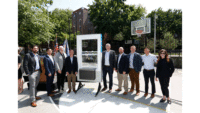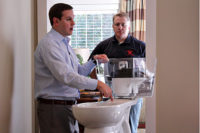“Multifamily was not as impacted as single family during the downturn,” said Lance Swank, president of the Sterling Group in Mishawaka, Ind. “The market continues to improve as new household formations generate demand, especially in the rental segment. There is also a change in attitude toward renting – people like the flexibility it gives and the option to be able to easily move to another city or state for a job opportunity.”
Swank made his remarks during a news conference last month at the International Builders’ Show in Las Vegas. He further noted that 100,000 to 150,000 multifamily housing units are taken out of service every year, which further fuels demand.
David Crowe, chief economist for the National Association of Home Builders, said developers built 246,000 multifamily units in 2012, which is a 38% increase from 2011.
“We are forecasting construction of 299,000 new multifamily residences in 2013,” Crowe said, noting this represents a 22% improvement over 2012. “In 2014, we forecast 317,000 multifamily units will be built, and that will be 6% over the previous year. While this is an improvement from just a few years ago, it is still well below the 350,000 units that are required to keep supply and demand in balance.”
Demographics are driving the demand for multifamily housing, he said, along with the aging building stock. During the residential construction boom, household formations reached 1.4 million per year. That number dropped to 500,000 during the downturn when workers experienced job loss or reduced wages. Many young people decided to live at home.
The 850,000 households now being formed per year have created pent-up demand for housing. People – especially in the 25- to 34-year-old age group – are feeling more comfortable about living independently.
“The 850,000 are all renters,” Crowe said. “The new households are young people who aren’t qualifying for mortgages. They eventually will become homeowners because we’re seeing a desire back to being homeowners. This will temper growth in multifamily construction in 2014 and 2015.”
Young people renting their own places are feeding a trend in multifamily construction toward smaller units in urban areas, Swank said. His company is not seeing this trend in the suburbs. In big cities, however, young people are renting one- and two-bedroom apartments in buildings – frequently high-rises – where they can walk to work.
Also factoring into the trend toward smaller units is the rise in construction costs, which Swank said are up 15%. Renters accustomed to the comforts of home want nice amenities in their apartments as well. They’re willing to sacrifice space to get the higher-end products.
Construction costs are increasing for a couple reasons. One is that manufacturers of building materials have been hesitant to bring back production capacity to pre-recession levels. A shortage of people to do the construction is contributing to the higher costs as well.
Rising costs on new projects eventually will be passed along to renters. This could serve as a further impetus for them to consider buying their own home. Until that happens, the demand for housing will generate work for firms that design plumbing and mechanical systems in multifamily buildings.



